


 |  |  |
 |
Home | _History_ | Hobbit Collection | Rare Books | Deluxe Editions | Signed Copies | Folio Society | Original Artwork | _Links_ | Checkout |  |
THE HOBBITIn the Summer of 1928, J.R.R. Tolkien began his popular literary career by writing the first line of the Hobbit, "In a hole in the ground, there lived a Hobbit". Tolkien worked on The Hobbit intermittently from this point up to its publication in 1937. Although a publishing contract was executed in 1936, there was still considerable work done on the book before it was finally published. In particular, Tolkien had to redraw &/or create the many illustrations and even the now famous dustjacket was not submitted until April 25, 1937. As with many aspects of his creative work, he was able to take elements from other sources and blend them into his own style. The Hobbit represents the first coming together of Tolkien's creative skills:
| 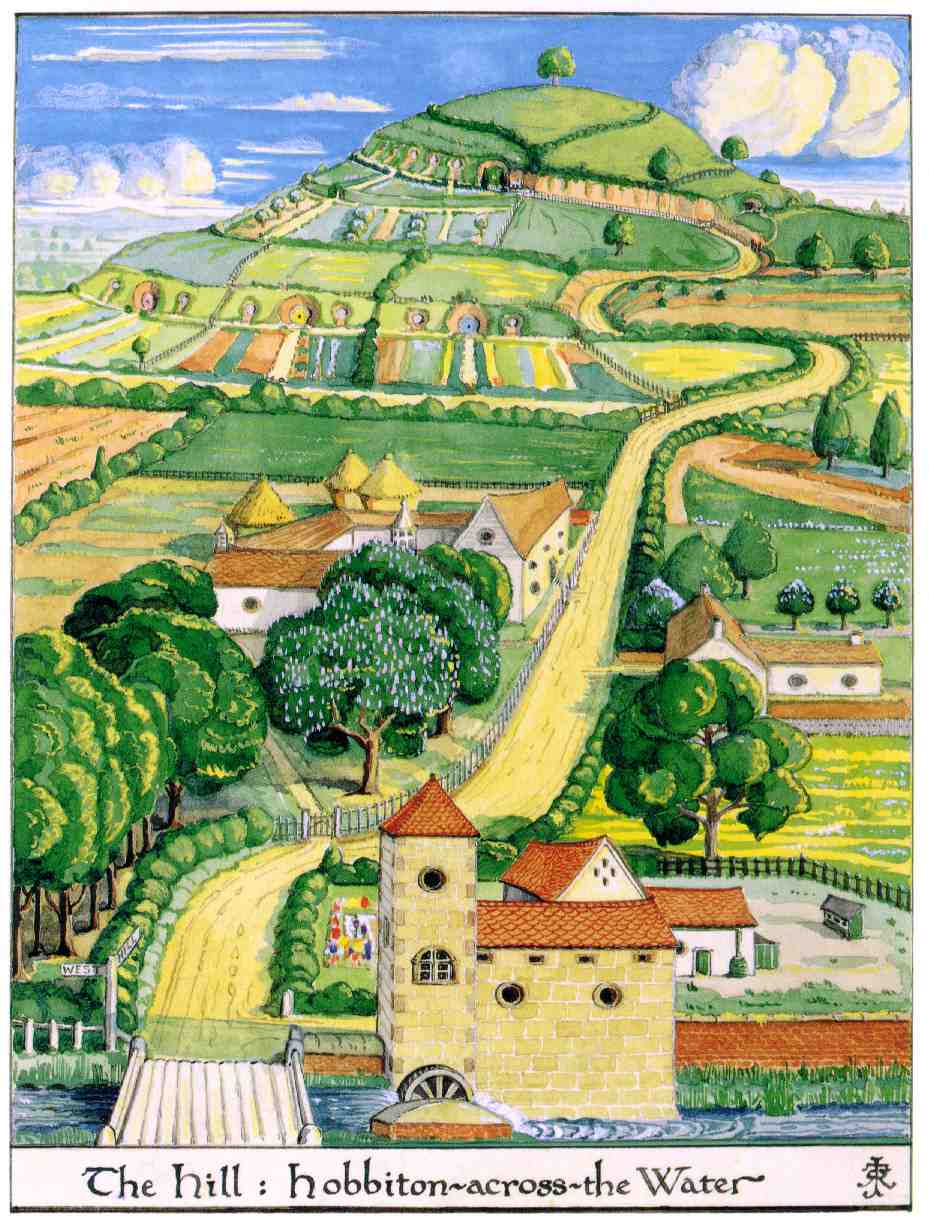 |
|
The First UK Edition The First Impression of the first UK edition was published September 21, 1937 by George Allen & Unwin Ltd. It was limited to only 1500 copies. The first UK editions prominently included the dustjacket designed by Tolkien. It was done in a wrap-a-round style in black, green and blue. It is certainly one of Tolkien's best illustrations and demonstrates his innate sense of visual design. It has become one of the most recognized book covers of all time. Originally Tolkien intended the flying dragon and the sun to be painted red, but budget restraints forced the red color to be substituted with black. The first printing had NO color illustrations within the book itself, instead 10 black-and-white illustrations along with the two maps printed in red and black. The book was constructed of green cloth boards and contained 310 pages. It was 19 x 13.5cm (7.48 x 5.31in). These boards were impressed with Tolkien's dragon and a delightful mountain scene along the top. |
 * This copy shown here was not only SIGNED by J.R.R. Tolkien |
Here is a list of errors cited by Hammond that the first impression was published with. It is unclear when all of these were corrected:
1. p14, ll. 17-18, 'find morning', for 'fine morning'.
2. p17, ll. 29-30, 'So you have got here at last! what (for That) was what he was going to say'.
3. p25, l. 11, 'more fierce then fire' for 'more fierce than fire'.
4. p62, ll. 2-3, 'uncomfortable palpitating' for 'uncomfortable, palpitating'
5. p62, l. 31, 'their bruises their tempers and their hopes' for 'their bruises, their tempers and their hopes'.
6. p64, l. 21, 'where the thrush knocks' for 'when the thrush knocks'.
7. p85, l. 10, 'far under under the mountains' for 'far under the mountains'.
8. p104, l. 17, 'back tops' for 'black tops'.
9. p147, l. 16, 'nor what you call' for 'not what you call'.
10. p183, l. 26, reversed double quotation marks for the word 'Very'.
11. p205, l. 32, 'dwarves good feeling' for 'dwarves' godd feeling'.
12. p210, l. 29, 'above stream' for 'above the stream'.
13. p215, l. 13, 'door step' for 'doorstep'.
14. p216, l. 4, 'leas' for 'least'
15. p229, ll. 16-17, 'you imagination' for 'your imagination'.
16. p248, l. 32, 'nay breakfast' for 'any breakfast'.
Here is the list of the black-and-white illustrations:
P4: The Hill: Hobbiton Across the Water
P49: The Trolls
P68: The Mountain-path
P117: The Misty Mountains Looking West from the Eyrie Towards Goblin Gate
P126: Beorn's Hall
P146: Mirkwood (halftone plate facing page 146)
P177: The Elvenking's Gate
P196: Lake Town
P209: The Front Gate
P307: The Hall at Bag End
front endsheet: Thror's Map. printed in black and red
back endsheet: Wilderland, printed in black and red
|
The Second Impression
| 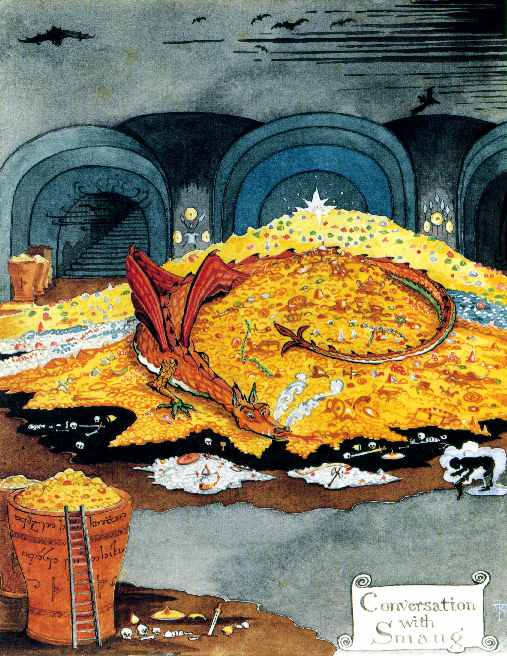 |
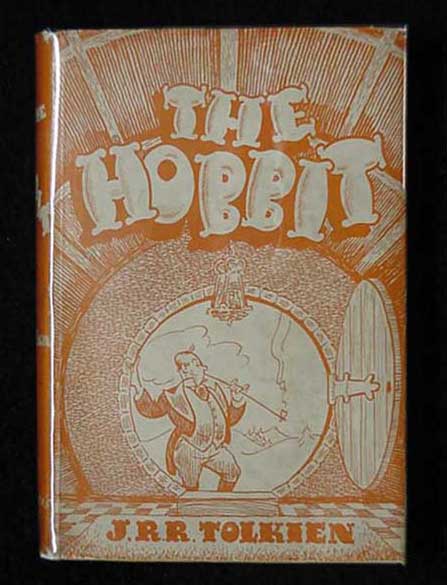 |
The Third Impression
p 183, the double quotation marks were reversed. p 216, 'leas' changed to 'least'. p 229, 'you imagination' changed to 'your imagination'. |
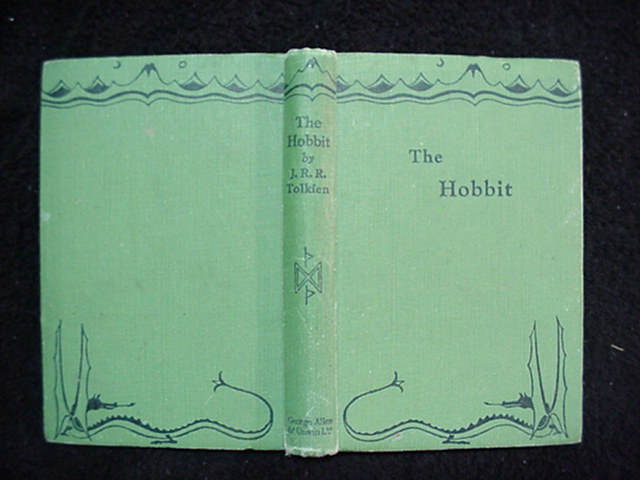
|
The Fourth Impression
p 14 'find morning' changed to 'fine morning'.
|
|
The First American Edition The first American editions of the Hobbit were published by Houghton Mifflin Company, Boston. It is evident that Houghton Mifflin printed the first American edition several times. The First Impression (commonly referred to as the First State) of the first American edition was published in 1938. The specific date is unknown, as is the exact number of copies of the first state. The Second Impression, or Second State was published March 1, 1938, limited to 5,000 copies. The first American editions differed significantly from the UK editions by the inclusion of four of Tolkien's color plates (a slightly different set of four were used in the second impression of the UK edition). Two of these were used on the dustjacket, the Hill: Hobbiton Across the Water (on the front cover) and Conversation with Smaug (on the back cover). Houghton-Mifflin also decided to place a small figure of a bowing hobbit on the title page and the bookcover. Unfortunately, this hobbit wore boots! To be fair to the publisher, this hobbit was modeled on the hobbit figure in Tolkien's illustration, Conversation with Smaug. The hobbit in the illustration also wears boots. This figure was removed at some point in production, probably as part of the second impression. For a brilliant and detailed description on identifying early US printings of The Hobbit, Click Here to see this article by Daan Strebe. |
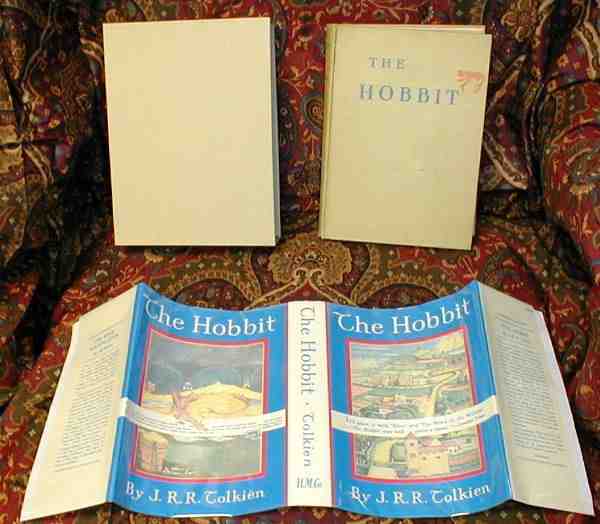
The First American Edition of The Hobbit. |
On the right is the second (and later) impression with the Houghton Mifflin device of a seated flute player. |
|
Second Edition of the Hobbit The second edition of the UK Hobbit was published in 1951 (3,500 copies). It is also referred to as the fifth impression. Page 8 is marked First Published in 1937, Second Impression 1937, Reprinted 1942, Reprinted 1946, Second Edition (Fifth Impression) 1951. The front of the dustjacket is marked "Fifth Impression". The dustjacket also includes press statements from The New Statesman and Nation, Observer, London Times and Lady. The text also has some corrections of the fourth impression but a number of errors remained. As Tolkien was writing the Hobbit sequel, The Lord of the Rings, he became aware of inconsistencies between the characterization of Gollum in the Hobbit and the features of desperation and obsession with the Ring that were required as motivation for his behavior in The Lord of the Rings. The original Gollum was less crazed and degraded by his long association with the Ring. As a result, Tolkien substantially revised Chapter 5. These are described in detail in the Annotated Hobbit.
|
THE LORD OF THE RINGSSeven for the Dwarf-lords in their halls of stone, Nine for Mortal Men doomed to die, One for the Dark Lord on his dark throne In the land of Mordor where the Shadows lie. One Ring to rule them all, One Ring to find them, One Ring to bring them all and in the darkness bind them in the land of Mordor where the shadows lie. The writing of The Lord of the Rings began shortly after the completion of The Hobbit but went on at intervals during the years of 1936 to 1949. Delays were increased by the outbreak of war in 1939, and by the end of that year the tale had not yet reached the end of Book One. In spite of the darkness of those days, Tolkien plodded on, mostly by night, til he stood by Balin's tomb in Moria. There he halted for a long time and it was almost a year later til he came to Lothlorien and the Great River in 1941. In 1942, he wrote Book Three and the beginnings of Book Five and then stopped...."foresight had failed and there was no time for thought". It was during 1944 that he wrote the journey of Frodo to Mordor. Still, it would take the next five years before the tale would be at an end. 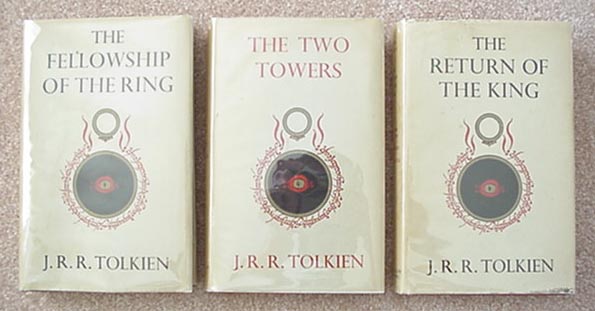 The first volume, The Fellowship of the Ring was published by George Allen & Unwin in the UK on July 29, 1954. The American edition, published by Houghton Mifflin Company of Boston, was released on Oct. 21, 1954.
A revised text version first appeared in Great Britian in a three-volume hardcover 'Second Edition' from Allen & Unwin on Oct. 27, 1966. In America, a revised text version appeared in a three-volume hardcover edition by Houghton Mifflin on Feb. 27, 1967.
|
| 'no-ogopogo' books
Kelowna, B.C. Canada Email Address : smaug@Hobbit.ca URL: http://www.Hobbit.ca Revised -- Dec. 10, 2014 |